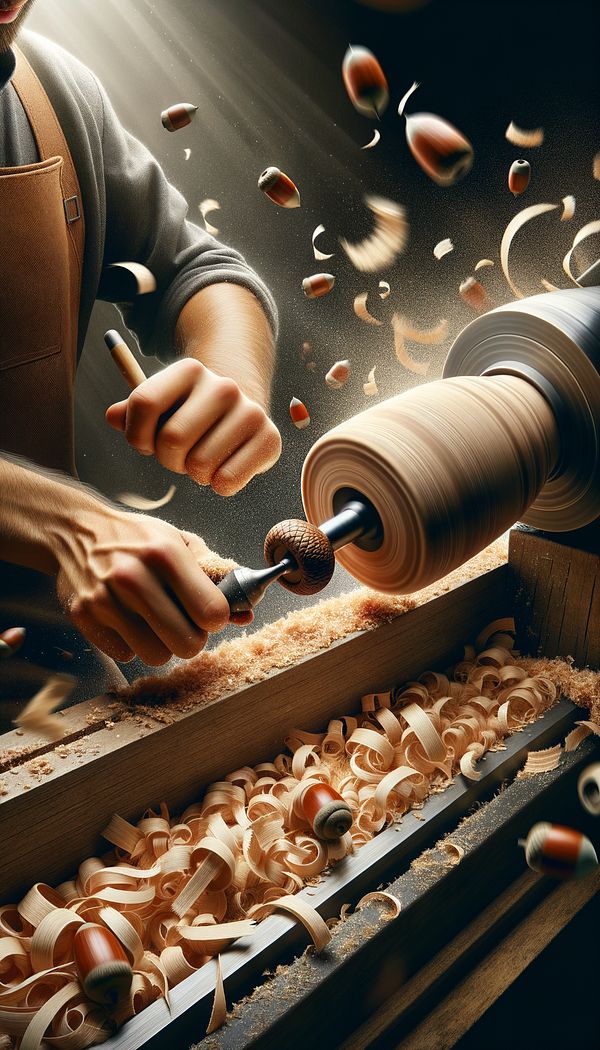What is Acorn Turning?
Acorn turning is a decorative woodworking technique.
Description
Acorn turning is a unique and ornamental woodworking technique that involves shaping wood on a lathe to create bulbous, rounded forms resembling acorns. This type of turning is considered a fine example of craftsmanship and detail in woodworking, allowing for the creation of intricate designs and patterns within an otherwise standard piece of furniture or wooden accessory. Acorn turnings are often seen in columns, legs of furniture, or as decorative finials atop posts or bedposts.
The process requires a high level of skill and precision, as the artisan must carefully control the lathe to achieve the desired acorn shape. Different woods can be used in this technique, each bringing its own color, grain, and texture to the final piece. The versatility of acorn turning allows for its incorporation into various design styles, ranging from traditional to contemporary, depending on the context of its use.
However, the appeal of acorn turning isn't limited to its aesthetic qualities alone. It also introduces a tactile element to wooden pieces, inviting touch and exploration of its smooth, contoured surfaces. This combination of visual and tactile allure makes acorn turning a favored technique among woodworkers aiming to add a signature touch to their creations.
Usage
Acorn turning is primarily used in the crafting of fine furniture and ornamental pieces, such as balusters, bedposts, and decorative columns. It can be found in both residential and commercial interior designs, contributing an element of classical elegance or country charm, depending on how it is styled. In modern contexts, acorn-turned pieces may serve as a focal point or conversation starter due to their intricate craftsmanship.
FAQs
-
Is acorn turning limited to traditional interior designs?
No, acorn turning can be adapted to fit a wide range of design styles, including contemporary settings. Its application depends on the overall design vision and how it complements other elements within a space.
-
Can any type of wood be used for acorn turning?
Most types of wood can be used for acorn turning, but the choice of wood impacts the final appearance and feel of the piece. Different woods offer variations in color, grain, and texture, which can enhance the decorative effect of the turning.
-
Do I need special tools for acorn turning?
Yes, acorn turning typically requires a wood lathe and specific turning tools. Mastery over these tools and the turning process is essential to achieving the precise, detailed shapes characteristic of this technique.
Practical Application
For interior designers and hobbyist woodworkers looking to incorporate acorn turning into their projects, it's essential to understand the characteristics of the wood being used and to have a firm grasp of the lathe operation. Starting with simpler forms and gradually progressing to more complex shapes can help in achieving skillfulness in this technique. Incorporating acorn turning into furniture or decorative pieces adds a unique, tactile element to interiors, bridging aesthetic appeal with craftsmanship.
-
Architectural Elements199 articles
-
Furniture Types599 articles
-
Decorative Techniques322 articles
-
Fabrication & Craftsmanship133 articles
-
Decorating Principles & Elements330 articles
-
DovetailDovetail is a type of interlocking joinery technique used in woodworking.
-
DownDown refers to the soft layers of fine feathers found beneath the tougher exterior feathers of birds, often used for insulation and padding in a variety of interior design elements.
-
DistemperDistemper is a water-based paint used on walls and ceilings.
-
Attached Back PillowAn attached back pillow is a cushion that is permanently affixed to a piece of furniture.
-
FirmnessFirmness refers to the physical strength and stability of a structure or material.
